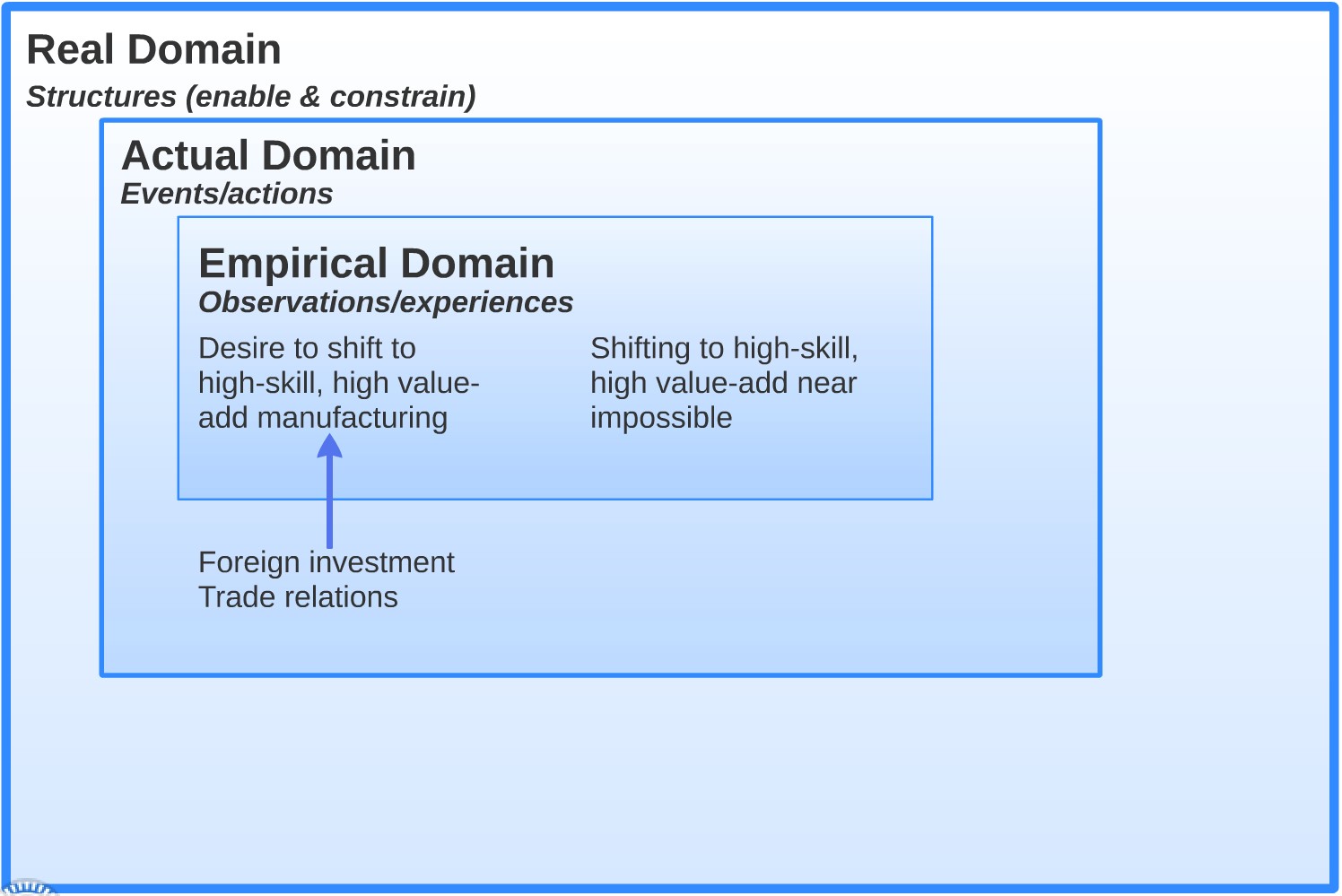Section audio
Let’s look at an example to see the utility of the critical realist framework for understanding organizations.
An Example of Applying a Critical Realist Framework: National Manufacturing Characteristics[1]
The situation
During the latter part of the Twentieth Century, low-skilled workers and low-value-added processes dominated the British manufacturing industry. British companies competed globally based on low cost.
Foreign investments and trade relations led some businesses to try shifting their manufacturing towards high-skilled labour and high value-added processes to make more profits.
Companies found making this shift was near impossible.
Recasting the situation through a critical realist lens
The desire to shift towards high-skilled labour and value-added processes is an experience (empirical domain). This experience was borne out of foreign direct investment and trade relations (events in the actual domain).
The difficulty businesses experienced in making this shift was another experience (empirical domain). The following figure diagrams this situation using a critical realist framework.

Why was making this shift so hard? It would seem all a company would have to do is hire highly skilled employees to work with high tech machinery to produce a high-value product. Simple, right?
To answer this, let’s look at the underlying structures enabling and constraining these businesses ‘ ability to act.
- At the time, the British labour pool had only low-skilled workers; thus, there were no high-skilled workers to hire (constraining structure).
- Consequently, managers in these businesses had no experience hiring or managing a high-skilled workforce (constraining structure).
- Additionally, government policies and cultural attitudes (structures) promoted training systems that produced low-skilled workers (action).
- Consequently, there was no pool of high-trained workers to draw from (constraining structure).
- In response, businesses developed wage systems and processes that accommodated this low-skilled workforce (action), which reinforced those constraining structures preventing the industry from moving to high-skilled, high-value work.
The following figure diagrams this situation using a critical realist framework.

In the above example, viewing Britan’s attempt to shift to a high-skilled, high value-add workforce through the lens of critical realism shows us why making such a change was difficult. The current system produced and maintained structures, which in turn supported and maintained the current system. Those same structures then created constraints on businesses that tried to shift to a different system.
Critical realism, however, does more than identify constraining structures. It also gives insight into what advocates must do to shift to high-skilled, high value-add processes.
The above example identified three constraining structures:
- lack of manager talent,
- a labour pool devoid of highly skilled workers, and
- government policies and cultural attitudes.
To shift the manufacturing regime to high-skilled, high value-add processes, advocates would have to train managers capable of managing a high-skilled workforce. They would further have to alter the education system to produce high-skilled workers. To do this, advocates would have to act to change government policies and cultural attitudes.
Viewing social systems through a critical realist lens allows us to identify those structures that support the status quo. The insights gained from this framework can tell you what actions you need to take to support the current system–that is, which structures do you need to reinforce and strengthen.
Conversely, if your goal is to change a system, the critical realist framework helps you identify what structures you need to alter and where points of resistance may lie.
Key Takeaways
- By gaining insight into the underlying structures of an organization, critical realism provides a framework to understand what actions are possible (and what efforts the organization will resist)
- By understanding these structures, individuals can develop plans to implement desired actions.
- Rubery, J. (1994). The British Production Regime: A Societal-Specific System? Economy and Society, 23(3), 335–354; adapted by Anderson, B. C. (2019). Values, Rationality, and Power: Developing Organizational Wisdom--A Case Study of a Canadian Healthcare Authority. Bingley, United Kingdom: Emerald Group Publishing Limited. ↵

